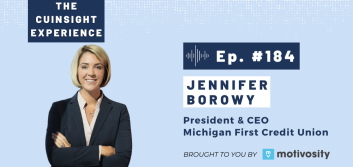Building better data today

When it comes to data, quantity is almost as important as quality. It is through the massive amount of labeled data that platforms such as ChatGPT are possible. What could credit unions achieve if they had access to that much data?
Banks have already seen this opportunity: the largest banks in America have already partnered to share data and increase their analytics power and are reaping the rewards. One such win comes from JP Morgan Chase, who was able to identify 766,000 individuals who had no credit score and got a credit card in their hands for the first time. On average, a person keeps their first credit card for about 10 years – that’s 10 years JP Morgan Chase can spend promoting other products and services.
For credit unions to compete, they need access to a large source of verified, shared data that is unique to credit unions and the communities they serve.
Benefits of a credit union data exchange
Participating in a data exchange would provide credit unions with a variety of opportunities for growth and advancement, including promoting a more widespread adoption of a data-driven culture. Currently, we are aware of a few credit unions that have reached a more mature level of data analytics, while the majority of credit unions are still at a very beginner level, if they’re utilizing analytics at all. By making this level of data readily available, more credit unions can begin making data-driven decisions.
Think of a credit union data exchange like Google Maps: when Maps first came out, it could get you from point A to point B. As more people started using it, and more data was collected from the users, the capabilities expanded. Now, Maps can tell you how long until you reach your destination, where there’s traffic, alternate routes to take to get there faster, and even where there are speed checks and red-light cameras. Thanks to data, you can now optimize your commute to get there faster, safer and with less risk.
With a credit union data exchange, credit unions can use the cumulative data to identify growing trends, allowing credit unions to take steps to either take advantage of the trend or avoid a growing risk.
Your credit union could use the data to plan a route to increase membership amongst certain demographics. Maybe your credit union primarily serves a baby boomer population but you want to attract more generation z members. You can utilize the data provided by other credit unions who have already made that journey to see what route they took to arrive at that destination.
A data exchange could also be used to create an “accident ahead” warning for credit unions. With data collected from credit unions across the US, any shift in the data could be used to predict potential economic downturns or a rise in defaulted payments.
What about a speed check warning? With more data, your credit union could identify what you’ll need to invest in if you grow quicker than expected. Will you need more branches, more staff, more server space? Accessing data from credit unions who have already gone through a growth phase can allow credit unions currently experiencing one to avoid some of the growing pains.
Keeping credit union data safe
A data exchange could certainly make life easier for many credit unions, but would it also open a door to increased risk?
Not necessarily. First and foremost, a data exchange should be owned and controlled by credit unions. That will do a lot to remove the risk of exploitation. Investing in the right infrastructure will keep the data itself safe. Data should be anonymized, and the contributing credit unions should be able to control what data is shared and with whom.
Secure file transfer protocol should be observed when sharing any data, and automated processes should be used to avoid the risk of human error. Any human interaction with the data pool should be automatically captured and audited for signs of manipulation or fraud.
The future of data
Machine learning and AI-powered algorithms aren’t the future of banking: they’re the present. Investing in a data exchange will give credit unions access to highly accurate predictive models that can then guide them through any coming economic fluctuations, member trends or any other traffic credit unions might encounter.
Trellance is proud to be building such an exchange, and to be working with Filene Research Institute to provide the research and the platform to help credit unions get access to the data they need to make accurate, powerful data-driven decisions, and to build the momentum they need to really make an impact on US banking. Trellance is currently accepting credit unions to participate in the exchange; for more information, visit CUDX.com.





